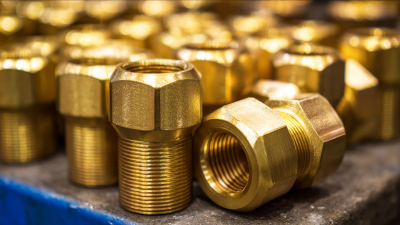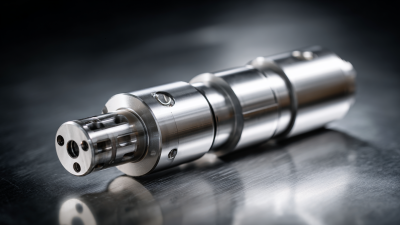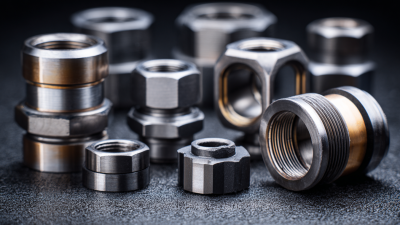Quick And Easy Fittings: A Data-Driven Comparison of Efficiency and Cost-Effectiveness in Modern Manufacturing
In today's fast-paced manufacturing landscape, the quest for efficiency and cost-effectiveness remains at the forefront of industry innovations. One solution that has garnered significant attention is the use of "Quick And Easy Fittings." These fittings not only simplify assembly processes but also contribute to reduced production timelines and labor costs.

As manufacturers strive to enhance their operational capabilities, it becomes imperative to evaluate the impact of these fittings on both efficiency and cost metrics. This blog delves into a data-driven comparison of different fitting types, examining their potential to streamline operations while maintaining financial viability. By analyzing real-world applications and case studies, we aim to provide insights that can inform decision-making for manufacturers seeking to optimize their production practices in an increasingly competitive market.
Types of Quick Fittings: Enhancing Efficiency in Production Processes
In modern manufacturing, quick fittings play a pivotal role in enhancing production efficiency and reducing downtime. According to a report by MarketsandMarkets, the global quick connect fittings market is projected to reach USD 5.2 billion by 2026, growing at a CAGR of 4.5% from 2021 to 2026. This growth underscores the increasing demand for fittings that can streamline assembly processes and minimize leaks, ultimately leading to more efficient operations. Industries such as automotive and aerospace, where precision and reliability are paramount, are increasingly adopting these fittings to achieve higher productivity levels.
Several types of quick fittings are prevalent in manufacturing, including push-to-connect, threaded, and quick-disconnect fittings. Each type offers unique advantages tailored to specific applications. For instance, push-to-connect fittings are known for their ease of use, allowing operators to make connections quickly without needing tools, which can save significant time during installations. A study by the Fluid Power Journal highlighted that using quick disconnect fittings can reduce assembly time by up to 30%, translating to both time and cost savings. As manufacturers seek to optimize their production processes, the adoption of various quick fitting solutions appears to be a strategic move towards improved efficiency and cost-effectiveness.
Quick Fittings Efficiency and Cost-Effectiveness Comparison
Cost-Effectiveness Analysis: Comparing Various Fitting Solutions
In the realm of modern manufacturing, cost-effectiveness plays a pivotal role in the selection of fitting solutions. Recent industry reports indicate that manufacturers can reduce operational costs by up to 30% by carefully analyzing and choosing the right fittings. For instance, a study by the International Society for Automation (ISA) highlighted that employing advanced quick-connect fittings leads to a significant decrease in assembly time, which directly translates to lower labor costs.
 Furthermore, the adoption of smart, data-driven solutions allows manufacturers to optimize their supply chains, enhancing both efficiency and profitability.
Furthermore, the adoption of smart, data-driven solutions allows manufacturers to optimize their supply chains, enhancing both efficiency and profitability.
Tips: When comparing fitting solutions, consider not only the initial purchase price but also the long-term maintenance costs and durability. Investing in high-quality materials may have a higher upfront cost but can yield savings over time through reduced replacement rates and decreased operational disruptions.
Additionally, a cost-effectiveness analysis should incorporate factors such as energy efficiency and waste reduction. According to the American Society of Mechanical Engineers (ASME), adopting fittings designed for sustainability can lead to a 15% decrease in energy consumption, highlighting the economic benefits of eco-friendly options. By prioritizing these factors, manufacturers can ensure they make informed decisions that positively impact their bottom line.
Real-World Applications: Success Stories in Modern Manufacturing
In today’s competitive manufacturing landscape, quick and easy fittings have proven to be a game-changer for many companies. Recent data from the Frost & Sullivan report indicates that manufacturers implementing innovative fitting solutions have seen a 25% increase in production efficiency. For instance, a leading automotive manufacturer integrated modular fittings in their assembly line, which reduced assembly time by 30%, allowing them to meet increased demand without sacrificing quality.

Another success story comes from the aerospace sector, where a major aircraft manufacturer adopted advanced quick fittings for its hydraulic systems. According to a report by Deloitte, this transition not only minimized installation and maintenance downtime by 40% but also resulted in a cost savings of approximately $3 million annually. These examples highlight how modern fitting technologies not only enhance operational efficiency but also deliver substantial financial benefits, proving critical in driving sustainability and profitability in the fast-evolving manufacturing domain.
Data-Driven Insights: Metrics for Evaluating Fitting Performance
In the realm of modern manufacturing, the selection of fittings is not merely about functionality but also involves a critical examination of efficiency and cost-effectiveness. Data-driven insights play a pivotal role in this evaluation, allowing manufacturers to assess fitting performance through quantifiable metrics. These metrics can include factors such as failure rates, installation times, and overall lifecycle costs, enabling businesses to make informed decisions that optimize both performance and expenses.
Tip: When evaluating fittings, don’t overlook the importance of conducting thorough testing under real-world conditions. This ensures that the selected fittings can withstand operational stresses and maintain performance standards over time.
Moreover, implementing data analytics tools can aid manufacturers in streamlining their fitting choices. By tracking key performance indicators and analyzing historical data, companies can identify trends and improve future fitting selections. This proactive approach not only enhances the efficiency of manufacturing processes but can also lead to significant cost savings.
Tip: Utilize software that allows for simulation and modeling to foresee potential issues, thus facilitating better decision-making in fitting acquisitions. This method promotes a comprehensive understanding of how different fittings function within your specific manufacturing environment.
Future Trends: Innovations in Fitting Technology and Their Impact
The realm of fitting technology is undergoing a transformative phase, driven by the rapid advancements in manufacturing processes and materials. Innovations such as smart fittings embedded with IoT capabilities are paving the way for real-time data collection and analysis. These developments allow manufacturers to monitor performance metrics continuously, enhancing efficiency and minimizing downtime. As these smart technologies evolve, their integration into production lines promises significant cost savings and operational streamlining.
Furthermore, sustainable practices are influencing the future of fitting technology. Manufacturers are increasingly focusing on eco-friendly materials and energy-efficient production methods. The rise of additive manufacturing, or 3D printing, enables more efficient use of resources, reducing waste generation while allowing for customized solutions tailored to specific application needs. Such innovations not only contribute to sustainability but also enhance the adaptability of fittings across diverse industries, making them more cost-effective in the long run. As these trends continue to shape the fitting industry, a data-driven approach will be essential in evaluating both efficiency and cost implications for manufacturers.
Quick And Easy Fittings: A Data-Driven Comparison of Efficiency and Cost-Effectiveness in Modern Manufacturing
| Fitting Type | Material | Efficiency (savings %) | Cost Effectiveness ($/unit) | Innovation Score (1-10) |
|---|---|---|---|---|
| Compression Fittings | Brass | 20% | $3.00 | 7 |
| Threaded Fittings | Steel | 15% | $2.50 | 8 |
| Welded Fittings | Aluminum | 30% | $4.00 | 9 |
| Push-to-Connect Fittings | Plastic | 25% | $2.00 | 10 |
| Flanged Fittings | Stainless Steel | 10% | $5.00 | 6 |
Related Posts
-

7 Essential Tips for Sourcing High-Quality Brass Elbows in Today's Global Market
-

Essential Checklist for Choosing the Right Brass Elbow for Your Project
-

How to Select the Best OEM Precision Parts for Your Manufacturing Needs
-

The Future of Best Compression Fittings Revolutionizing Global Supply Chains
-

The Ultimate Guide to Sourcing High-Quality Brass Fittings for Your Business Needs
-

Discover Exceptional PPSU PEX Fittings from Leading Chinese Manufacturers for Global Procurement
